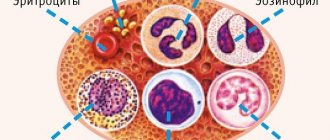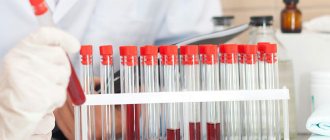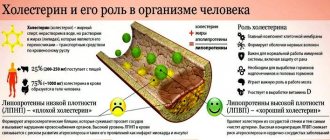Biological role of AST and ALT
Alanine aminotransferase (ALT) and aspartate aminotransferase (AST) are enzymes produced in almost all cells of the human body. The maximum concentration is determined in the following organs:
- liver;
- cardiac muscle - myocardium;
- skeletal muscles;
- kidneys;
- nerve tissue.
Aminotransferases are detected in smaller quantities in the tissue of the lungs, spleen and pancreas.
ALT and AST are catalysts for certain biochemical reactions. They ensure the transfer of amino groups and participate in the formation of vital organic acids.
Normally, ALT and AST are located inside cells. In a healthy person, their concentration in the blood is low. The release of enzymes occurs during cell necrosis. ALT and AST leave the destroyed tissues and enter the bloodstream. Enzymes do not have organ specificity, and their concentration does not always correspond to the severity of the disease.
Aspartate aminotransferase
Aspartate aminotransferase is a marker of damage to the heart muscle. In the myocardium, its activity is 10 thousand times higher than in the blood serum of a healthy person. An increase in AST during myocardial infarction is one of the early markers of the disease. And although its specificity is low, determination of the AST level is used in the diagnosis of cardiovascular pathology.
In liver diseases, AST is considered a less specific enzyme. Its level is growing, but gastroenterologists focus on a different indicator - ALT.
Alanine aminotransferase
Alanine aminotransferase is a specific marker of liver disease. With hepatitis of various origins, the concentration of ALT increases. The enzyme level is usually proportional to the severity of the disease.
In case of liver pathology, ALT and AST are simultaneously determined, but the first enzyme is considered a more accurate marker. The AST assessment is of a supportive nature.
During myocardial infarction, ALT levels do not rise as quickly as AST. With uncomplicated necrosis of the heart muscle, the concentration of alanine aminotransferase may remain within normal limits.
Summing up
People who experience liver problems should stop smoking . Cigarette smoke contains a large number of toxins, which include nicotine and ammonia.
If a person is exposed to these substances every day, they are automatically absorbed by the body and retained in it. The liver in such a state of the body will strive to rid it of toxins, simply working for wear and tear.
Against the background of such work, the amount of enzymes in the blood increases, since after such a load the liver begins to malfunction, causing certain health problems. It is for this reason that it is so important to eliminate or minimize alcohol consumption .
Following these relatively simple rules will improve not only your overall well-being, but also your appearance. A healthy liver has a positive effect on the condition of the skin, hair and nails.
These materials will be of interest to you:
Similar articles:
- What to do if your eyes are watery? Treatment at home Regardless of whether there are certain problems with…
- What to do if your heart hurts? First aid It is difficult to find a person who has never experienced pain...
- What to do if there is an abscess on the gum? Toothache may not be evidence of caries in all situations...
Source: lechenie-narodom.ru
The most interesting:
Indications for assessing enzyme levels during pregnancy
The determination of AST and ALT refers to liver function tests (LFTs). This examination is included in the biochemical blood test. In practice, aminotransferases are almost always determined together with alkaline phosphatase (ALP). Taken together, these indicators make it possible to identify some pregnancy complications.
A biochemical blood test (including assessment of AST and ALT) is prescribed to all women twice during pregnancy:
- at the first visit to the doctor;
- at 30 weeks.
A blood test is carried out regardless of the patient’s complaints and condition and is indicated even against the background of complete health. Determination of liver enzymes is a screening test and allows you to identify hidden pathology.
According to indications, aminotransferases are determined at any stage of pregnancy. The following conditions may be the reason for examination:
- Suspicion of liver disease. Analysis for ALT and AST is prescribed when viral or toxic hepatitis, cholecystitis, etc. are detected. Assessment of enzyme levels is also indicated in the presence of specific complaints indicating pathology of the liver and biliary tract: pain in the right hypochondrium, nausea and vomiting, itching, jaundice.
- Suspicion of myocardial infarction. The reason for the examination is the appearance of complaints (severe pain in the chest, spreading to the left arm, shoulder, under the shoulder blade) and characteristic changes on the ECG.
- Monitoring the patient's condition with liver and heart pathologies.
- Suspicion of skeletal muscle diseases.
- Diagnosis of complications of gestosis. An increase in aminotransferases is observed in preeclampsia, cholestasis of pregnancy and acute fatty liver degeneration.
Available treatment in the third trimester
If ALT is increased during pregnancy in the 3rd trimester, then most likely the woman is accompanied by headaches, dizziness, nausea, and pain in the temporal region. These symptoms are characteristic of late gestosis and can cause quite significant discomfort. The load on the liver can be caused by the presence of diseases such as pancreatitis, heart disease, thyroid disease, genitourinary system, untreated infectious and inflammatory processes in the body. Definitely, this should not be ignored.
Treatment methods for elevated ALT in the blood during pregnancy come down to helping the liver perform its functions and recover. Therefore, any toxic drugs are excluded. Moreover, most of them are contraindicated for women during pregnancy. Doctors choose drugs that are made on a plant basis. These include: “Essentiale N”, “Tykveol”, “Gelabene”, “Legalon”. They protect the cells of the organ and restore it, and also perform functions that the liver cannot currently cope with. For example, this could be a secretory function, participation in metabolic processes, getting rid of toxic products.
Preparing for the examination
Rules for donating blood to determine aminotransferases:
- Blood is taken for analysis in the morning on an empty stomach: after fasting for 8-14 hours.
- On the day of the examination, you can drink plain water without gas.
- You can take a blood test during the day, 4 hours after a light snack.
- The day before the study, you need to exclude physical activity and emotional experiences.
- Alcohol intake is prohibited on the eve of the procedure.
The results of a biochemical blood test are assessed by a gynecologist or therapist. According to indications, other specialized specialists are involved in the diagnosis.
Reasons for increased aminotransferases during pregnancy
Normally, the level of AST and ALT in a woman over 17 years of age should not exceed 31 U/l. In young pregnant women (up to 17 years of age), the indicators remain within 24 U/l. During gestation, the concentration of enzymes in the blood remains virtually unchanged. A decrease in AST and ALT in the first trimester of pregnancy is allowed, but this has no clinical significance.
Conditions in which ALT and AST increase:
- liver diseases in which cell necrosis occurs;
- heart diseases accompanied by myocardial necrosis;
- pregnancy complications associated with liver cell damage;
- intestinal pathology with damage to its cells and their death;
- severe and extensive burns;
- heatstroke;
- toxic shock syndrome;
- neurological diseases with damage to brain cells (stroke);
- kidney infarction;
- taking hepatotoxic drugs.
There is an increase in aminotransferases after heavy physical activity and during prolonged fasting. Overweight women experience some increase in enzymes.
Let's take a closer look at the most common causes of increased ALT and AST during pregnancy.
Diseases of the liver and biliary tract
Possible reasons:
- Acute viral hepatitis A, B, C, D, E and others. When infected, liver cells are destroyed and enzymes are released. There is an increase in ALT levels by 50-100 times or more. AST is not growing that much. An increase in enzyme activity occurs even before the development of jaundice - during the prodromal period. In 50% of patients, enzymes increase 5 days before the manifestation of the disease, in 90% - 2-3 days. In the anicteric form of viral hepatitis, an increase in aminotransferases is also observed. With a favorable course of the disease, ALT gradually decreases (over several weeks). A sharp increase in enzymes occurs in the fulminant form of acute hepatitis, often leading to death.
- Chronic viral hepatitis. There is a slight increase in enzymes: 4-5 times. In some situations, ALT and AST levels remain slightly above normal.
- Toxic hepatitis. There is a moderate increase in transaminase levels. As necrosis progresses, the levels of ALT and AST increase.
- Cirrhosis of the liver. An increase in enzymes by 4-5 times is observed. The AST level is higher than ALT.
- Malignant liver tumors. Aminotransferases increase 10 times or more. In the early stages of the disease, indicators may remain within normal limits.
- Taking medications. Some medications lead to liver damage and destruction of its tissue. There is a slight increase in enzymes.
- Obstruction of the bile ducts. There is a moderate increase in transaminases: 2-4 times.
Preeclampsia
Preeclampsia is a severe complication of gestosis. Characterized by the appearance of the following symptoms:
- increased blood pressure;
- swelling;
- proteinuria (the appearance of protein in the urine).
Without treatment, it leads to the development of eclampsia - muscle spasms of the face and body. Death occurs from cerebral hemorrhage or pulmonary edema. The fetus dies from acute asphyxia.
For the timely detection of complications of gestosis, monitoring of some blood parameters, including ALT and AST, is carried out. An increase in enzyme levels indicates involvement of the liver in the process and the imminent development of preeclampsia.
Acute fatty liver degeneration
Acute fatty hepatosis is a rare complication of the second half of pregnancy. The following symptoms appear:
- pre-icteric stage: weakness, nausea, heartburn, itchy skin;
- icteric stage: change in color of the skin and mucous membranes;
- liver failure.
The level of ALT and AST increases in the preicteric stage. The increase in transaminases is insignificant - 2-3 times. With timely diagnosis, pathology can be noticed and the development of liver failure can be prevented.
Cholestasis in pregnancy
Intrahepatic cholestasis of pregnancy occurs in the third trimester. Accompanied by jaundice and itchy skin. In most cases, it disappears without a trace after the birth of the child. The exact cause of the development of the pathology is unknown.
With intrahepatic cholestasis, there is an increase in ALT and AST by 2-4 times. A sharp increase in enzyme levels is not typical. Changes in blood counts are observed even before the first symptoms appear or in the early stages of the disease.
Myocardial infarction
Myocardial infarction is damage to the heart muscle caused by an acute disruption of the blood supply. The cause is blockage of the vessel by atherosclerotic plaque. Rarely occurs during pregnancy. The disease is more often detected in people over 40 years of age against the background of previous vascular pathology.
Myocardial infarction is disguised as other conditions: diseases of the stomach, spine, lungs. An ECG is performed for diagnosis. If necrosis of the heart muscle is suspected, the woman is hospitalized.
An increase in AST levels is one of the first signs of myocardial infarction. The concentration of aspartate aminotransferase changes with the development of cardiac necrosis. An increase in AST is observed in the first 8 hours after the onset of an attack of myocardial infarction. The enzyme peaks between 18-24 hours. A day later, AST activity decreases and reaches normal on the 5th day of the disease. In relation to myocardial infarction, there is a direct relationship between the level of the enzyme and the size of the lesion.
How to help a pregnant woman
The ALT level in women in the first trimester of pregnancy is considered a good indicator. This is due to the fact that not only hormonal changes occur, but also an active exchange of blood cells between the mother and the growing fetus. Only a qualified specialist can give a specific assessment of a woman’s health status.
If the reason for the increase in alanine aminotransferase levels is a lack of vitamin B, then restorative therapy is prescribed, which includes vitamins B and C, hepatoprotectors. It is also worth noting that normalizing the diet is one of the main ways to normalize ALT levels in the blood. It is believed that eating brown rice, fruits and vegetables, green or any herbal tea has a positive effect on restoring liver function.
The goal of treatment is not to reduce indicators, but to eliminate the inflammatory process, which leads to an increase in ALT during pregnancy. Only in this case can we talk about the possible restoration of the organ and health in general.
Tactics for increased transaminases
An increase in ALT and AST is a reason for additional examination:
- advanced biochemical blood test;
- blood test for viral hepatitis;
- ECG;
- Ultrasound of the abdominal organs;
- assessment of the fetus' condition (ultrasound, CTG).
Further tactics will depend on the reason for the increase in enzymes:
- If viral hepatitis is detected, consultation with an infectious disease specialist is indicated. In acute cases of the disease, hospitalization is carried out in a hospital. In the chronic stage, treatment is prescribed on an outpatient basis.
- If toxic hepatitis is detected, detoxification therapy, unloading of the liver, and monitoring of the condition of internal organs are carried out.
- In case of cholestasis, the abolition of all medications except vital ones is indicated. Hepatoprotective drugs are prescribed.
- For gallbladder pathology, treatment can be conservative or surgical, depending on the cause of the disease.
- Preeclampsia and acute fatty hepatosis become indications for emergency delivery. Priority is given to caesarean sections. At the same time, infusion therapy is carried out.
- In case of myocardial infarction, assistance is provided by a cardiologist. Treatment is carried out taking into account the severity of the disease and the duration of pregnancy.
ALT and AST are markers of the condition of the liver, heart and other internal organs. If the indicators increase, a doctor's consultation is necessary. Timely identification of the cause of enzyme growth increases the chances of a favorable pregnancy outcome.










